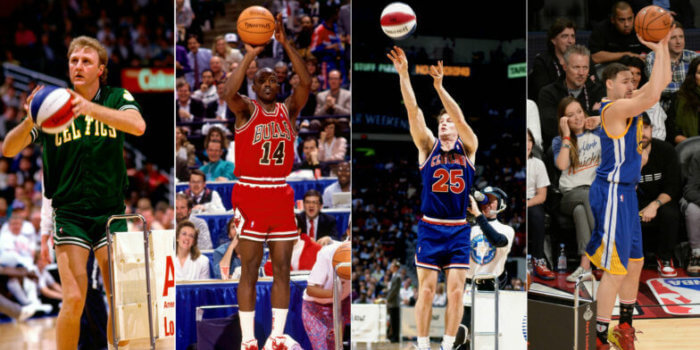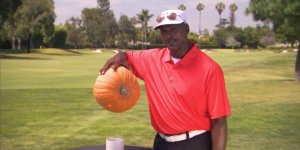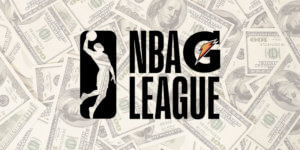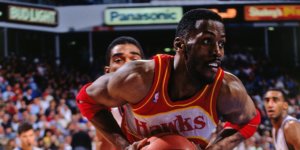Data was last updated on 4th of February 2022 to include the first half of the 2021/22 season.
If you watch footage of old '70s NBA basketball you'll notice immediately how different the game looks. Players are clogging up the middle, daring players to shoot from outside and the set-play action is much slower and more methodical.
Compare that to today, and offenses are much more spread out with a lot of space in the paint that allows players to attack the basket more easily.
There are many reasons for this change, but the biggest is the addition of a 3-point line. Since its introduction to the NBA in 1979, it has completely changed the way basketball is played!
When Did The NBA Create The 3-Point Line?
1961: Invention and the introduction in the ABL
The 3-pointer was first used in the American Basketball League (ABL) in 1961. Abe Saperstein, the founder of the Harlem Globetrotters, had created the league to compete with the NBA and he felt strongly that the little man was being forced out of the game by all these giants hanging around the rim.
He wanted to do something about this "problem" and so he invented the 3-point line as a chance for smaller players to make up for their lack of height with their shooting skills.
As it turns out, Abe Saperstein was ahead of his time as the ABL only lasted a season and a half and many basketball purists were appalled by the "gimmicky" 3-point shot.
1967: Comeback in the ABA
The 3-point play was an important part of the ABA's plan to challenge the NBA. They wanted to make the game of basketball more exciting and fun and saw the 3-pointer as the equivalent to a home run in baseball. The idea was to give smaller players a chance to compete and bring the fans out of their seats.
In the first ABA season 1967/68, teams took on average 5 three-pointers a game, which does not sound like much by today's standards but is almost double the amount compared to the first NBA season 12 years later (2.8 3PA per game).
The most notorious 3-point shooter during this first season was Les Selvage of the Anaheim Amigos. He attempted 461 threes, not just more than any other ABA player but more than any other ABA team but Pittsburgh! His 10-26 shooting night from the 3-point line against the Denver Rockets was a record that would hold for decades.
The merger of the ABA and NBA in 1976 was the temporary end for the 3-pointer as the more traditional NBA didn't want to introduce the 3-pointer (yet).
1979: The NBA 3 Point Line
The NBA three-point line is 23'9" from the middle of the rim (22' in the corner) and was introduced in the 1979-80 season for a one-year trial. The first 3-pointer in the history of the NBA was made by Boston Celtic Chris Ford.
Brian Taylor (who was used to the 3 from his days in the ABA) led the NBA in 3-point makes and attempts (90/239) closely followed by Rick Barry (73/221). A young Larry Bird attempted 143 three-pointers in his rookie season and made 58 (.406) which ranked him third in 3-point percentage overall.
1984-1988: All leagues Implement the 3
Once the three-pointer made it to the NBA it was easy to get other leagues to implement it as well. FIBA introduced the 3-point line for international play in 1984, the NCAA used it first universally in 1987 and high school basketball followed a year later.
A Closer Look at the 3-Point Line
Abe Saperstein wanted to call the three-pointer the "25-foot home run" but other founding members of the ABL thought that this was a little too far out. They managed to find a compromise and drew the three-point line 25 feet from the backboard instead of the middle of the rim - the same 23' 9" three-point distance still used in the NBA today!
But unlike free-throw distance which is universal among basketball leagues, the three-pointer has varied wildly from league to league and sometimes from year to year.
3-Point Line Distance by League
| League | Distance in feet | Distance in meter |
|---|---|---|
| NBA | 23' 9" (22' in the corner) | 7.24 m (6.71 m in the corner) |
| 1994-95 to 1996-97 | 22' | 6.71 m |
| 1979-80 to 1993-94 | 23' 9" (22' in the corner) | 7.24 m (6.71 m in the corner) |
| WNBA | 22' 1¾" (21' 7 ⅞" in the corner) | 6.75 m (6.25 m in the corner) |
| NCAA Men | 22' 1¾" (21' 7 ⅞" in the corner) | 6.75 m (6.25 m in the corner) |
| 2007/08 to 2018-19 | 20' 9" | 6.32 m |
| 1986-87 to 2007/08 | 19' 9" | 6.02 m |
| NCAA Women | 20' 9" | 6.32 m |
| FIBA | 22' 1¾" (21' 7 ⅞" in the corner) | 6.75 m (6.25 m in the corner) |
| 1984 to 2010 | 21' 7 ⅞" | 6.25 m |
| High School | 19' 9" | 6.02 m |
Evolution of 3-Point Shooting in the NBA
How many three-pointers do teams take per game?
When the NBA introduced the 3-pointer in the 1979-80 season, it had minimal impact on the game at first. In the first five seasons, teams took less than three 3-pointers a game and made only a dismal 26% of them. It took a while until the 3-point shot was more widely accepted and utilized.
3-Point Attempts started to rise slowly with the 1986-87 season and reached 9.9 shots per game in 1993-94 before it jumped to 15.3 attempts the next year caused by the decision of the NBA to move-in the 3-point line by two feet.
After the NBA moved back the line in 1998 again the trend continued and 3-point attempts rose slowly almost every year until they started to explode in 2013. In the 2021-22 season, NBA teams take on average 35.1 3-point attempts. That's almost double the number of shots compared to 2011-12!
If we take a closer look at the numbers by position, we see that until the 2007-08 season, the distribution of 3-point shots among teams was clear: point- and shooting guards attempted the most shots, small forwards closely followed them while power forwards shot very little from deep and centers almost never.
In recent years that has changed a lot. Today, PGs, SGs, SFs, and PFs all take a similar amount of 3-pointers, only centers are still shooting significantly less threes.
In a league, where the most popular play is a 1-5 pick'n'roll with positions 2-4 spreading the floor, it's not surprising to see 3 point-attempts of wings and even power forwards continuing to rise.
Average 3-Point Percentage in the NBA
Unsurprisingly, NBA players were pretty bad at shooting three-pointers in the beginning. In 1982-83, the worst 3-point shooting season of all times, teams only made 23.8% of their shots!
3-Point percentage climbed to around 30% in the early '90s and peaked during 1996 when the 3-point line was 2 feet shorter. Since 2000, the 3-point percentage has been relatively steady hovering between 35% and 37% leading to the impression that NBA players have reached the limit of what's possible.
Has 3-Point Accuracy Reached a Limit?
Probably not! Although the 3-point percentage has not been getting better in the last 10 years, players are shooting more and (more difficult) 3-pointers every year and are able to keep the percentage steady.
While players would only take wide-open shots from the three-point line a few years ago, today we see players like James Harden who are able to shoot difficult step-back threes with very high accuracy!
Some of the best 3-point shooters manage to shoot almost 50% for the season!
We can see that in the last twenty years PGs, SGs, SFs, and PFs are shooting very similar percentages. Only Centers are still clearly worse from deep but even they are getting much better in the last 5 years.
These numbers illustrate how important shooting ability is in the NBA these days, even Centers need to be able to shoot a decent percentage from deep to keep the floor spread and make it easier for guards and forwards to attack the rim.
Why are Players Shooting so Many Three-Pointers in the NBA?
Old-school fans of the '90s NBA often complain that there is way too much 3-point shooting today and that the mid-range game that made players like Michael Jordan and Kobe Bryant unstoppable is pretty much extinct. And they are not wrong!
Teams like the Houston Rockets under Mike D'Antoni made it their strategy to only shoot 3-pointers or layups. But why is that?
The expected shot value is calculated as % of making a shot * value of the shot.
So for example, if you shoot 40% on 3-pointers, the expected value of a 3-point shot is 3pt*40%=1.2.
The chart above shows, that once NBA players got good enough at shooting 3-pointers, the expected value of 3-pointers has been higher than the expected value of two-pointers for every season since 1991/92 with the exception of 2021/22.
So the simple reason why teams shoot so many 3-pointers these days is that they make more points this way!
Will Teams Shoot Even More Threes in the Future?
In a very simplified world, teams should shoot more 3-pointers as long as the expected value of a 3-pointer is greater than the expected value of a 2-pointer.
We can see that the difference between the two shots has become smaller and smaller in recent years. In 2000-01, the average 3-pointer netted 0.14 points more than the average 2-pointer, so there was a very high incentive to shoot more 3-pointers as it was a far more productive play.
In 2022, the shot selection has changed drastically and the difference is almost zero! Players no longer shoot a lot of inefficient mid-range jumpers and because of that the expected value of a 2-pointer has risen from 0.92 in 2000-01 to 1.07 in 2021-22.
At the same time, the expected points per 3-point attempt have decreased because teams are defending the three point line better and better and players take more difficult off-the-dribble threes than they used to.
Mathematically, there's no incentive to shoot even more 3-pointers in the future as we reached an optimal shot distribution with the current rules and player skillset.
Note: There might be some added complexity that changes this math as offensive rebound percentage and the rate with which players get fouled should be different from 2-point to 3-point shots.
If players get even more skilled at deep shots, the NBA changes the rules, or teams develop new defensive strategies to better defend 3-pointers, this might change again and teams using advanced analytics would adopt to get the most out of every shot.
References
- Data was collected from basketball-reference.com
- Loose Balls - Terry Pluto








This is the BEST article on 2+3 point shooting, analysis of team and player tendencies EVER. The interactive charts are AWESOME! A most excellent read and highly informative.